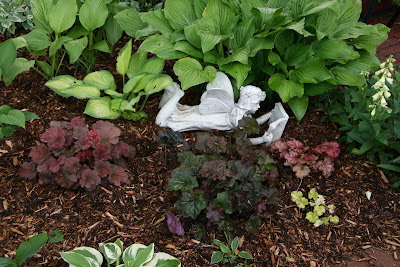 |
| Wiese Acres Fairy Garden |
Fairy gardens are usually thought of in miniature and are found in a container of some sort. You can produce a similar feeling on a large scale, creating an entire garden location around that theme.
 |
| Wiese Acres Woodland Fairy Garden |
Other plants that are said to attract fairies but require more sun than my spot provides are roses, calendulas, daffodils, dogwoods, daisies, flax, hollyhocks, lavender, morning glories and rosemary. If you want to create a fairy garden in a sunnier spot, these plants are sure to lure fairies to your location.
I've also used plants whose names reflect the fairy theme. Elfin pink penstemon, Fairy snapdragons, Fairy cranesbill and Elfin Thyme all grow on the sunnier side of the Woodland Fairy garden. Foxglove, which is also known as "Fairy petticoats", make a wonderful background plant for the fairy garden.
Statuary and other structures make the fairy theme more obvious to the casual meanderer. Fairy statuary on a larger scale than that normally found for the container or small scale fairy gardens are readily available at most garden centers. The secret to making them fit the fairy culture is to tuck them in amongst the leaves, rather than leaving them fully in the open. Fairies are playful tricksters, and they would rarely ever make themselves readily visible to humans.
 |
| Wiese Acres Woodland Fairy Garden |
 |
| Wiese Acres Woodland Fairy Garden |
Fairies also love to play and dance, so tucking tiny fairy "toys" such as miniature gazing balls, or picnic tables under some of the leaves will help give the cheerful, carefree fairy feeling to the garden.
It must work, because any tricks that have been played on me have been purely my own doing.

No comments:
Post a Comment